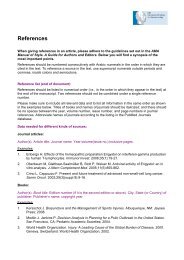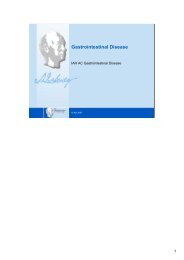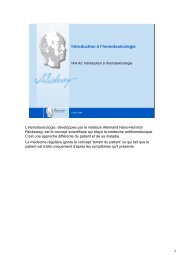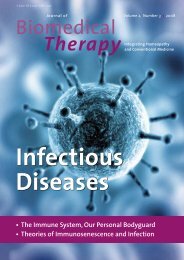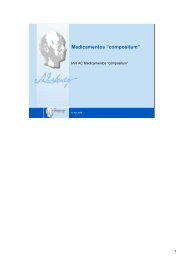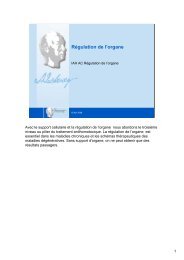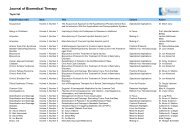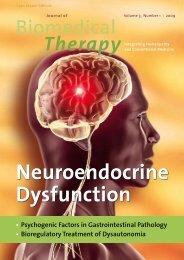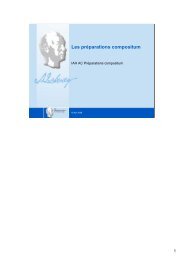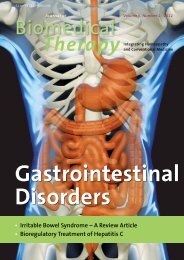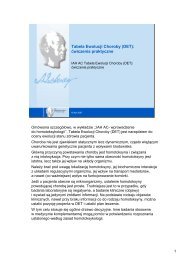Metabolic Syndrome - International Academy of Homotoxicology
Metabolic Syndrome - International Academy of Homotoxicology
Metabolic Syndrome - International Academy of Homotoxicology
Create successful ePaper yourself
Turn your PDF publications into a flip-book with our unique Google optimized e-Paper software.
) Making <strong>of</strong> ...<br />
Left:<br />
The fodder <strong>of</strong> the donor pigs consists <strong>of</strong><br />
cereal groats, organically-grown soy<br />
groats, and minerals.<br />
Right:<br />
Proper cleaning and disinfecting <strong>of</strong> the<br />
animals’ stalls are effected according to<br />
the requirements <strong>of</strong> the Ministry <strong>of</strong><br />
Agriculture’s hygiene regulations.<br />
substitute pig organs for scarce human<br />
organs in transplantation medicine.<br />
From the homeopathic perspective,<br />
a pig-derived potentized<br />
organ product can be considered a<br />
“simile” <strong>of</strong> the homologous human<br />
organ(s). For this reason, stronger<br />
effects are being attributed to pig<br />
organ preparations than to products<br />
derived from cattle or sheep. 2<br />
Breeding and husbandry<br />
Pigs destined to supply the raw materials<br />
for homeopathic organ extracts<br />
for antihomotoxic medications<br />
are provided by a breeding operation<br />
that is certified to be free <strong>of</strong><br />
specific pathogens and under constant<br />
veterinary oversight to ensure<br />
compliance with all applicable hygiene<br />
regulations <strong>of</strong> the German<br />
Federal Ministry <strong>of</strong> Agriculture. The<br />
brood sows all come from the same<br />
breeding line. The future donor pigs<br />
stay with their mother until they are<br />
six weeks old, and her milk is their<br />
primary food until they are weaned.<br />
After weaning, the litter stays together<br />
and the piglets are raised<br />
separately from other pigs to prevent<br />
the stress and fights for dominance<br />
that may ensue if new animals<br />
are introduced into the group. The<br />
animals’ stalls are cleaned and disinfected<br />
before occupancy. The breeding<br />
operation must abide by all <strong>of</strong><br />
the Ministry <strong>of</strong> Agriculture’s hygiene<br />
regulations applicable to hog<br />
rearing, including requirements for<br />
proper cleaning and effective disinfection.<br />
Non-employees must wear<br />
either disposable outer garments or<br />
protective clothing provided by the<br />
company, and their shoes must be<br />
cleaned and disinfected before entering<br />
the stall areas.<br />
The pigs’ fodder consists entirely <strong>of</strong><br />
plant materials (cereal groats) grown<br />
on the farm itself, supplemented<br />
with purchased protein (soy groats)<br />
and minerals. The soy groats are organically<br />
grown to ensure that this<br />
critical feedstuff is free <strong>of</strong> genetically<br />
engineered products. Feeding <strong>of</strong><br />
food scraps or animal by-product<br />
meals from mammals is both legally<br />
and contractually forbidden. In addition<br />
to monitoring by the state<br />
Animal Health Service for compliance<br />
with all health directives applicable<br />
to animal breeding operations,<br />
the animals are checked both at regular<br />
intervals and as needed by the<br />
company’s veterinarian. They are<br />
also examined by the district veterinary<br />
<strong>of</strong>ficer before shipping out.<br />
Safety measures<br />
Ensuring the microbiological safety<br />
<strong>of</strong> the final products involves an extensive<br />
checklist <strong>of</strong> procedures. Suitable<br />
sample tissues are selected for<br />
testing for the zoonotic pathogens<br />
most common in pigs. In southern<br />
Germany, where the pigs are raised,<br />
Salmonella spp., Campylobacter<br />
spp., and Yersinia spp. are the most<br />
relevant. Tests for these and other<br />
pathogens must be negative if the<br />
animal’s tissues are to be used in<br />
manufacturing suis-organ medicines.<br />
Separate records <strong>of</strong> test results are<br />
kept for each animal. Also available<br />
for reference are two files <strong>of</strong> materials<br />
from groups <strong>of</strong> experts. These<br />
files list and discuss all diseases<br />
known to occur in pigs, describe<br />
which <strong>of</strong> these diseases might theoretically<br />
occur in the geographical<br />
area and under the conditions in<br />
which the donor pigs were raised,<br />
and explain the measures to be taken<br />
to eliminate the possibility <strong>of</strong> using<br />
animals infected with these (theoretically<br />
possible) diseases.<br />
The above-mentioned standards <strong>of</strong><br />
livestock husbandry, feeding, and<br />
hygiene along with the combination<br />
<strong>of</strong> clinical, microbiological, and serological<br />
tests (some <strong>of</strong> which exceed<br />
government requirements)<br />
minimize the risk <strong>of</strong> using organs<br />
contaminated with hog-borne<br />
zoonotic pathogens and maximize<br />
the safety <strong>of</strong> the final organ products.|<br />
References:<br />
1. Schmid F (ed). Biological Medicine. Baden-<br />
Baden, Germany: Aurelia Verlag, 1991.<br />
2. Reckeweg H-H. Homotoxikologie – Ganzheitsschau<br />
einer Synthese der Medizin. 6th ed. Baden-<br />
Baden, Germany: Aurelia Verlag, 1986: 616.<br />
) 25<br />
Journal <strong>of</strong> Biomedical Therapy 2008 ) Vol. 2, No. 1



